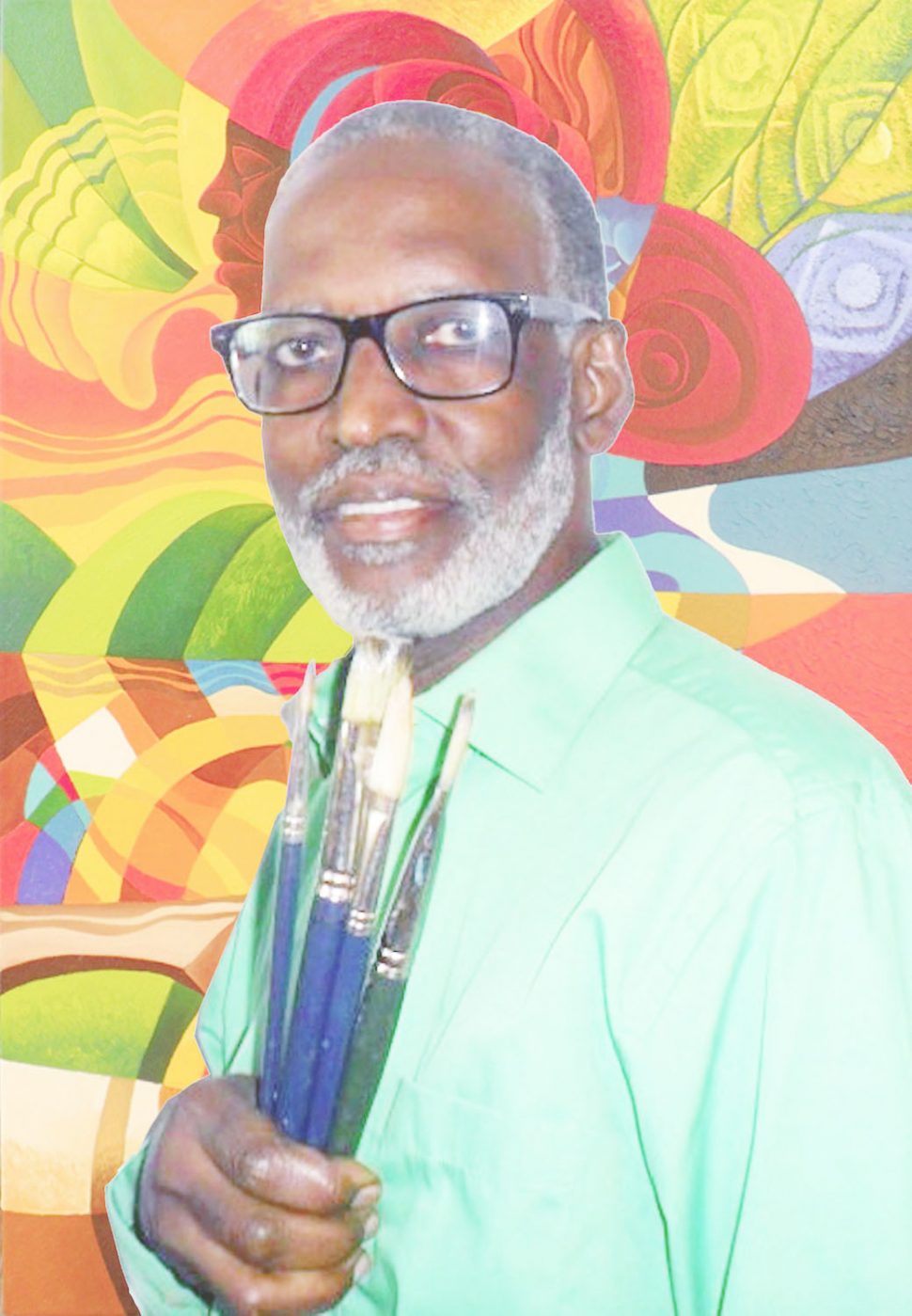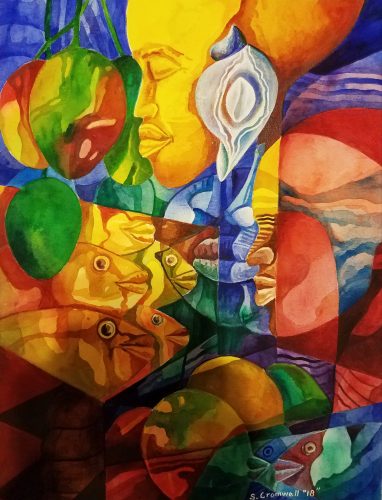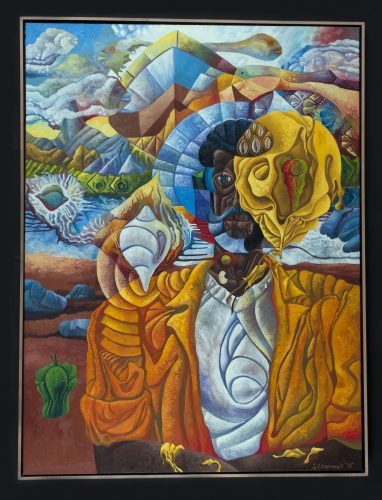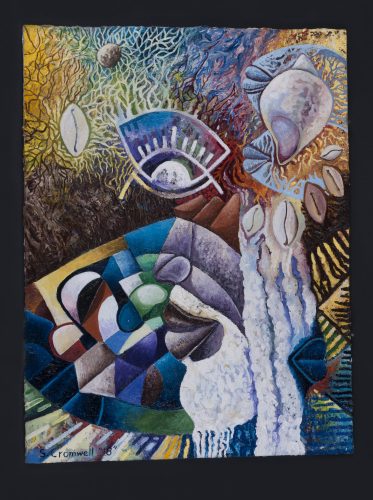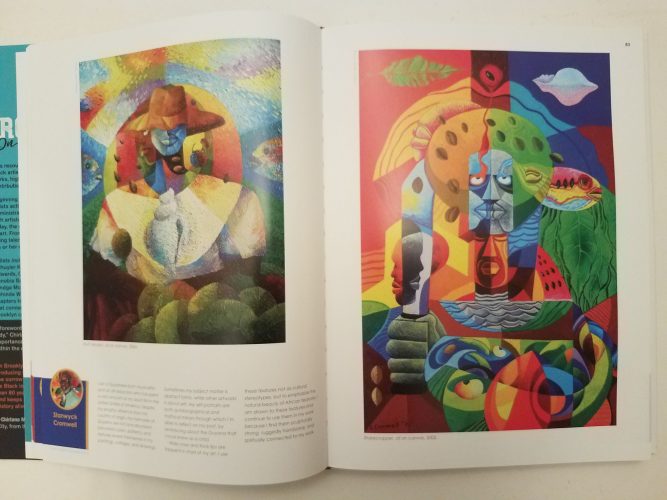He grew up in an artistic family, so it was no surprise that Stanwyck E Cromwell chose the world of art in which to immerse himself, but the journey has been far from smooth, as his move to United States immediately taught him that he needed to expand his creativity if he wanted to attract buyers.
Expand he did—this continues today—and while he would be the first to admit the challenges, his successes have been many as he brings his talent to canvas and paper with paint and brush and pencils.
“The road to becoming an artist in America, was and still is difficult,” he admitted in an interview with the Sunday Stabroek.
“Unlike Guyana, where almost every artist is Guyanese, in America artists are divided, with artists using their birthplaces as banners. You have Guyanese, Jamaicans, Barbadians and so on. Even among some Guyanese artists, there are biases, if you’re not part of that circle of friends…,” he added.
He described himself as a “contemporary visual artist” who has adapted to the style of Abstract Expressionism and one who still uses his child memories of his homeland to inspire his work even though he has made the United States his home for almost 50 years.
“My memories of Guyana are rich and abundant, but the most striking, are the physical and aesthetic distances between the cultures of Guyana and the United States of America. A visual kaleidoscope from this exotic place is referenced in my art. These references serve as visual footnotes to my art-making practice, by allowing me a rich palette of sights to draw from,” is how he describes the fusing of his two homelands in his artist statement.
Cromwell left Guyana at the age of 20, two years after he had completed his secondary education at the then Alleyne’s High School which was formerly known as British Guiana Educational Trust.
His father, cousins and uncles were all artists and his mother was a seamstress and a craftsperson. Having been exposed to the world of art at a young age, Cromwell said, art became “natural to me.” And like “any normal young male,” Cromwell said, he was mischievous but found refuge in his art “where I could retreat and become creative.”
And that creativity led him to designing t-shirts for various steel pan members. He enjoyed drawing so much that he was asked and at times volunteered to draw diagrams for his classes.
Of all his family members, Cromwell’s late cousin Maurice Jacobs (who died last September) was most influential in his pursuit of art.
Competitive
Cromwell recalled that when he arrived in the US, he realised that art was very competitive and he had to align himself with a college, or school of art.
“The thing that surprised me the most was that some high school students were doing the quality of art usually associated with experienced artists and college students were doing high quality work, usually associated with professionals,” he said in the interview.
He found that he had to make a big adjustment, coming from a tropical country, where the landscapes are colourful. “It took me a while to adjust to the climatic conditions,” he added.
Speaking to the challenges he faced as an artist in the US, Cromwell said one of the major ones was trying to create art images of Guyana. Because America is a multicultural country, Cromwell said, he made the conscious decision to create art that speaks to a wide variety of topics and people and realised that he could have held on to his Guyanese culture, but present it in a more visually impacting and appealing manner.
“I realised that unless the buyers of my art are Guyanese, my other customers from various walks of life won’t recognise certain iconic sceneries like the Kaieteur Falls, Stabroek Market, seawall, the Kissing Bridge, St George’s Cathedral and others. I had to adapt to a style of art that would later become my signature. The style is called Abstract Expressionism,” he disclosed.
Over the years Cromwell found that being an artist was very tough and at times mentally and financially exhausting. In addition to creating art, he also teaches art: lectures and workshops, pertaining to his profession.
“Art can also create stress and destroy marriages,” he said of his profession but added that he thankfully has a dedicated wife. He and his wife had two boys but unfortunately the younger, who was also an artist, passed away nine years ago. The couple is blessed with grandchildren and great grandchildren.
Cromwell has been living in the US for almost 50 years and over time he has been able to establish a reputation as a dedicated artist. This, he said, has helped him to rise above expectations.
He has done several solo and group exhibitions in which he sold several pieces of his work. Some of his work has been collected and published by collectors and publishers and two years ago he did a retrospective celebrating 50 years of art making.
Apart from being an artist Cromwell belongs to four visual arts organisations and he is also a Deacon at his church.
‘Prodigal sons’
He returned twice to Guyana since he migrated as he does not have family members here, but he expressed the wish to one day return and hold an exhibition even though opining that overseas-based artists are treated like “prodigal sons” in exile.
He shared that he had sent a letter expressing this wish, but he never got a response from the person he approached.
“I never heard from her. It seems to me that Guyana has never embraced her artists overseas. It’s like we don’t exist. Other countries have welcomed their artists from overseas. I trust that one day, during my lifetime, I, along with other Guyanese-born artists, would be invited to exhibit in Guyana,” he said.
Meantime, as a professor, Cromwell said, he inspires his students by sharing the process of art-making. The fact that he is a professor who creates art, as opposed to just talking about art, allows him to invite them to his exhibitions, where they get an opportunity to experience him outside of the classroom.
The artist hopes to create a cohesive body of work that will one day become a “testimony of my legacy.”
Two of Cromwell’s artworks are currently featured in an art book titled, Brooklyn On My Mind, by author, professor, artist and curator Dr Myrah Brown. The book features artists who made and make Brooklyn, their home. Having left his native Guyana in 1970, Cromwell lived in Brooklyn, NY for a while.
In his artist statement, Cromwell said his self-portraits are both autobiographical and mythical mirrors, through which he reflects on the Guyana he once knew as a child.
“Sometimes rendered in graphite and coloured pencils, sometimes collaged on with various papers, or found objects, my work celebrates the legacy of my Guyanese heritage. Therefore, for this reason, colour is central in my work. As an artist, I’m constantly exploring new artistic horizons with the intent of pursuing new visions,” he said.
And wide noses and thick lips appear frequently in his work.
“I use these features not as cultural stereotypes, but to emphasize the natural beauty of African features. I am drawn to these features, and continue to use them in my work, because I find them sculpturally strong, ruggedly handsome, and spiritually connected to my work,” he added.
“The multicoloured, mask-like images and abstract designs in my drawings, reflect the fusion of both the Guyanese-African and indigenous cultures and the rich pageantry of carnival. In addition, my work combines both imaginary and spiritual concepts, through myth and folklore. This process allows me to stretch my imagination to the fullest of its elasticity,” he shared.

